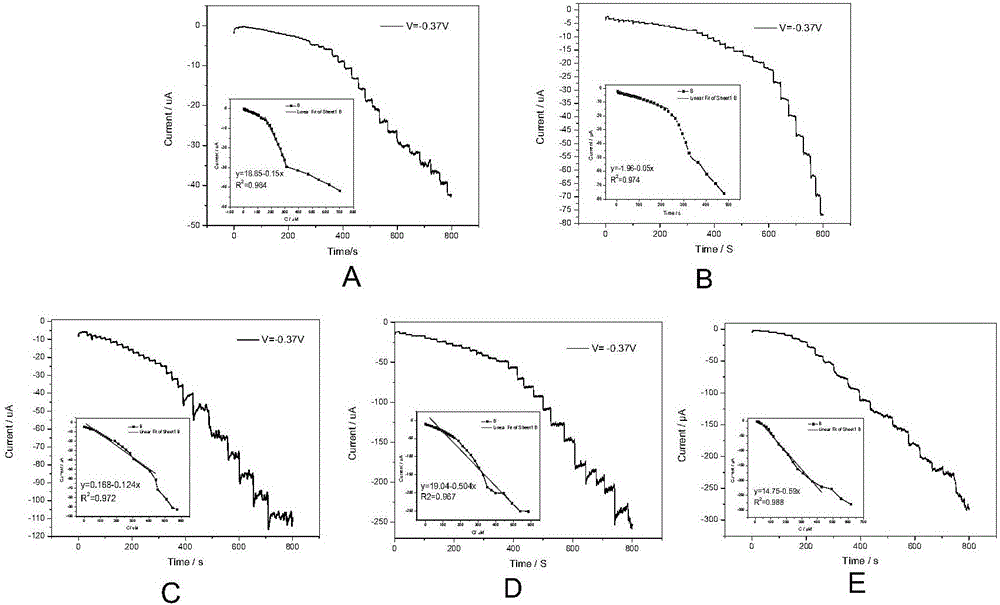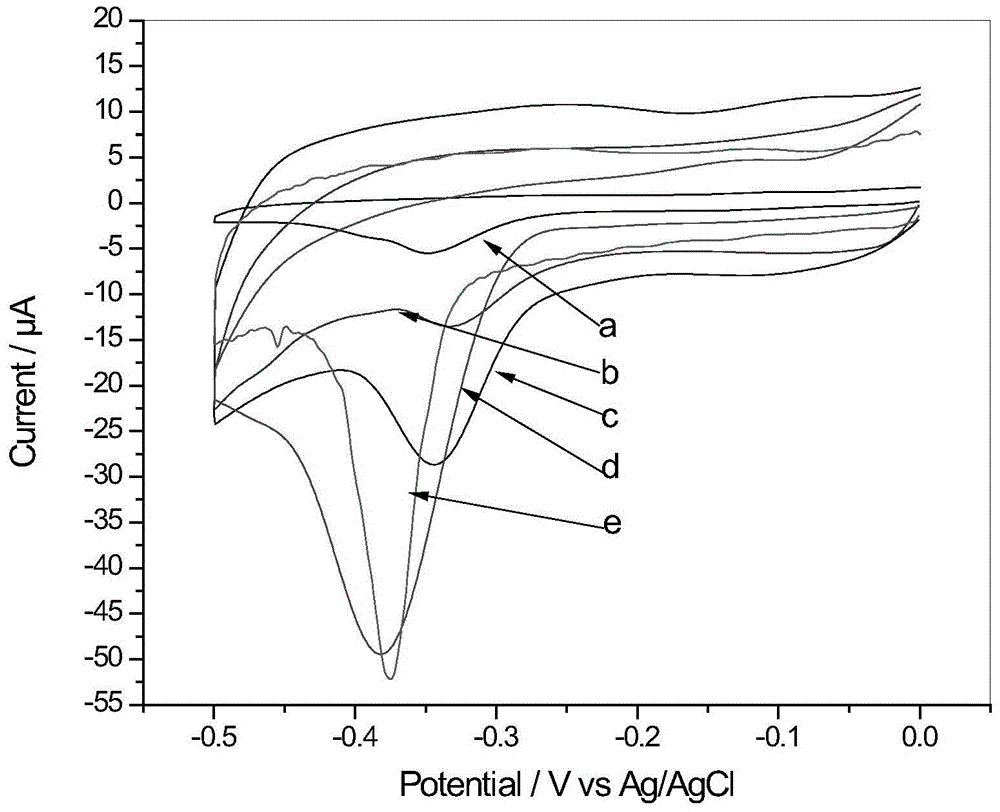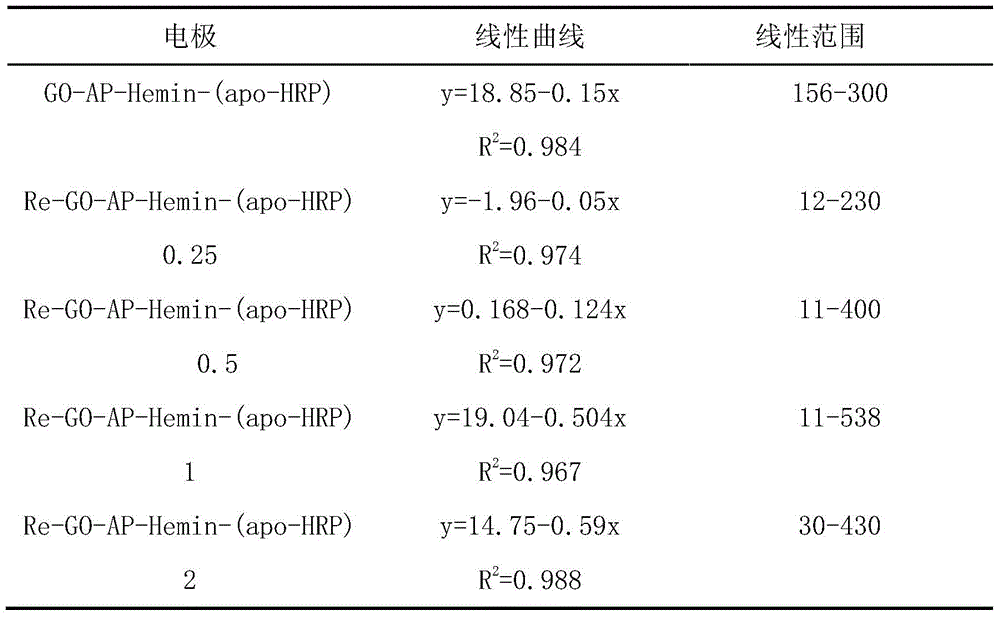Method for immobilizing protein by oriented affinity of conducting polymer modified vector
A conductive polymer and protein technology, applied to biochemical equipment and methods, and enzymes immobilized on or in inorganic carriers, can solve the problems of decreased activity of immobilized proteins, achieve biological activity retention, shorten distance, and improve active effect
- Summary
- Abstract
- Description
- Claims
- Application Information
AI Technical Summary
Problems solved by technology
Method used
Image
Examples
Embodiment 1
[0034] (1) 10 mg of graphene oxide (GO) was ultrasonically dispersed in 10 mL of pure water for 30 min to prepare a 1 mg / mL GO suspension. Weigh 500mg NaOH and 500mg ClCH 2 COONa was added into the GO suspension, ultrasonically reacted for 2 h, and the obtained product was neutralized with dilute HCl. Repeat washing with deionized water and centrifugation (10000rpm, 10min) until the product is well dispersed in deionized water. Finally, use a dialysis bag in deionized water, dialyze (molecular weight cut off: 8000-10000) for 48 hours to remove ions, and dilute the obtained GO-COOH suspension to 10 mL.
[0035] (2) Weigh 100mg (0.15mol) of Hemin into a three-necked flask, add 40mL of THF, stir to dissolve; raise the temperature to 70°C, and gradually add thionyl chloride (0.6mol) dropwise; after the dropwise addition, raise the temperature to 110°C , continue to react for 1h. The unreacted thionyl chloride and the solvent in the above reaction solution were distilled off to ...
Embodiment 2
[0041] Detection of hydrogen peroxide (H 2 o 2 ) The current response relationship of the substrate
[0042] (1) Prepare 78 μM H 2 o 2 solution;
[0043] (2) With the above-mentioned enzyme sensor as the catalytic electrode, the substrate is 78 μM H 2 o 2 solution; the measuring voltage is 0-0.5V, and the scanning rate is 50mV / s; the cyclic voltammetry curve (CV) of the biocatalytic system is tested.
[0044] exist figure 1 Among them, a is the unreduced modified enzyme, b is the reduction degree of 0.25, c is the reduction degree of 0.5, d is the CV curve of the reduction degree of 1 and e the reduction degree of 2. The measured catalytic current increases with increasing reduction degree. The electrochemical activity of the modified enzyme is much larger than that of the modified one, which is about 2 times that of the unmodified enzyme.
[0045] figure 2 And in Table 1, with -0.37V as the measurement voltage, the I-t curve of the HRP response was detected and obtai...
Embodiment 3
[0050] (1) 15 mg of carbon nanotubes were ultrasonically dispersed in 10 mL of pure water for 30 min to prepare a carbon nanotube suspension. Weigh 300mgNaOH and 300mgClCH 2 COONa was added to the carbon nanotube suspension, subjected to ultrasonic reaction for 2 h, and the obtained product was neutralized with dilute HCl. Washing with deionized water and centrifugation (10000 rpm, 10 min) were repeated until the product was well dispersed in deionized water to obtain a suspension of carboxylated carbon nanotubes.
[0051] (2) Weigh 100mg (0.15mol) of Hemin into a three-necked flask, add 40mL of THF, stir to dissolve; raise the temperature to 70°C, and gradually add thionyl chloride (0.6mol) dropwise; after the dropwise addition, raise the temperature to 110°C , continue to react for 1h. The unreacted thionyl chloride and the solvent in the above reaction solution were distilled off to obtain the acid chlorided Hemin.
[0052] Under cooling in an ice-water bath, weigh 0.5 g...
PUM
 Login to view more
Login to view more Abstract
Description
Claims
Application Information
 Login to view more
Login to view more - R&D Engineer
- R&D Manager
- IP Professional
- Industry Leading Data Capabilities
- Powerful AI technology
- Patent DNA Extraction
Browse by: Latest US Patents, China's latest patents, Technical Efficacy Thesaurus, Application Domain, Technology Topic.
© 2024 PatSnap. All rights reserved.Legal|Privacy policy|Modern Slavery Act Transparency Statement|Sitemap



